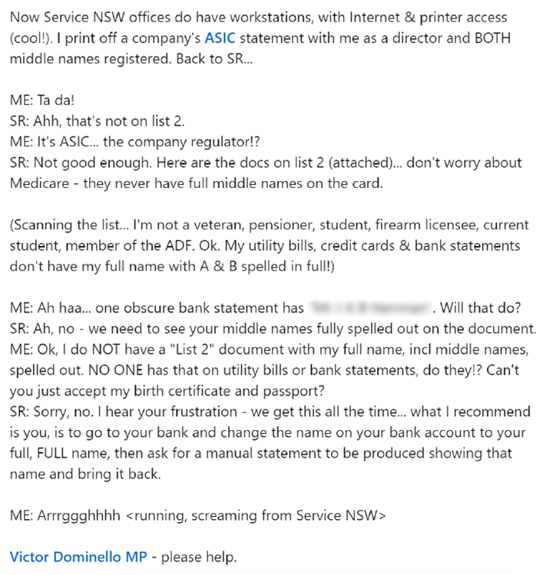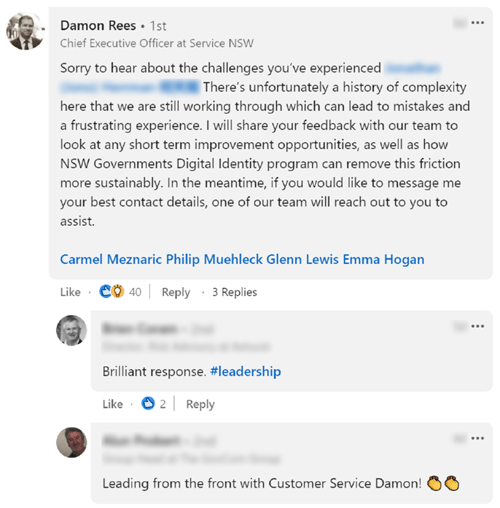"Public sector leaders can no longer afford to sit out of modern engagement platforms. To be effective, they are expected to have profiles and communications narratives that are authentic and reliable. Anonymity simply doesn’t work any more."
Ready or not, they are.
I love this statement on the need for public sector leaders to change their style from The Australian Financial Review. Whether you agree or not, it highlights an uncomfortable truth: leaders have never been more visible or vulnerable than right now. Anonymity simply doesn’t work. And the key driver behind this is citizens’ monumental shift towards digital engagement channels over the past 24 months.
Today, people make decisions based on what searchable platforms like Google, LinkedIn, Twitter, Glassdoor and others say about you online. Not what you say or do in the offline world.
But far from being something to avoid and run (screaming) from, we have already seen wonderful examples of leaders turning into and embracing this new digital reality to profound effect. The benefits being increased trust, strengthened relationships and talent attraction among others – things all leaders need.
So, if participation – not avoidance – is the right strategy today, how should public sector leaders best harness that opportunity?
The case for change.
Whether you’re a leader or trusted communications adviser, it’s worth first highlighting the unique factors influencing trust and reputation in the digital age. Here are the facts:
- Active social media users grew by 10.1% last year, according to the 2022 Global Digital Insights Report.
- 74% of people expect leaders to use social media to communicate publicly. And staff would prefer to work for a leader who uses social media by more than a 5:1 ratio over one who does not, according to the 2021 Connected Leadership Report.
- And 81% of people believe leaders should be personally visible when discussing key policies and actions online, according to the latest Edelman Trust Barometer.
If you lead or are advising a public sector leader today and individual digital participation is not part of your communications strategy, according to these numbers you are now behind the 8-ball.
The Edelman Trust Barometer goes on to show government has fallen dramatically from a trust high of 65 in May 2020 to 52 today, almost 10 points behind the corporate sector. Government is also seen as the most divisive force in society, ahead of media. And Government leaders are the least trusted among societal leaders surveyed.

How many examples of quality public sector leadership are seen online today? How many leaders have you seen participating authentically, purposefully and regularly online?
If the link between trust and digital participation isn’t immediately obvious, the consequences certainly are. It’s time for change.
Learning from public sector leaders.
Some have made this change and are already reaping the rewards. I love sharing practical examples that show how protecting and enhancing your digital reputation can be achieved while in public sector leadership.
Just look at the fantastic example set by the likes of Amanda Yeates, Amy Brown and Mike Kaiser. Or for more quantitative evidence, have a look at the detailed analysis we wrote, working closely with intelligence platform Brandwatch, looking into the efforts of Premier Daniel Andrews during COVID.
But rather than getting into the details on these individuals, the best examples of digital leadership come from those public sector leaders working in partnership – a ‘digital coalition’. After all, no single leader can appeal to every key stakeholder group, and trying to do so may challenge their authenticity. Instead, by harnessing the power of a digital coalition, individual leaders are empowered to be themselves, working in an aligned, coordinated fashion with their peers online knowing they don’t need to be everything to everyone to get the job done.
While certainly not glamorous, I saw a very practical and effective example of this approach at work recently on LinkedIn among the senior leaders at the NSW Department of Customer Service. Rather than building bottlenecks and ‘key person risk’, the leadership team works collaboratively online to field queries, take action and build trust with key stakeholders. No major content production budgets, no highly scripted statements – just listening, learning and taking action. Have a look.


Despite the critical nature of the post and attention it generated, the leadership team swung into action and showed they were present, listening and using the feedback to improve process.


A public exchange that addressed a public grievance yet led to public praise. This is the opportunity for leaders to build a purposeful digital presence in partnership with peers to restore trust by showing they are present and willing to help.
Valuing your digital reputation.
So, as a leader, what steps should you take to build, protect or enhance your digital reputation? Or what advice should you give leaders if you’re advising them? There are five important steps:
-
-
-
- 1. Clarify your vision. Define your 'why', which should embody both organisational and personal ambitions. This improves your focus – and reduces your risk – on all future online efforts.
-
- 2. Build a symmetrical profile. Google is now the owner of first impressions and how the world sees you online matters. Make sure your online profile is consistent with what people see of you offline as well.
- 3. Deepen awareness of key stakeholders. Make sure you have access to the right sources of information to help you continue learning about the needs of key stakeholders. This will inform your content, your tone, your responses – everything.
- 4. Commit to purposeful engagement. Taking intentional actions online protects and enhances your digital reputation. Avoid 'thoughtless’ posting and engagement efforts – you leave a digital footprint wherever you go online.
- 5. Grow your network of advocates. Like your online activities, the strength of your online relationships protects and enhances your digital reputation. Ensure you’re surrounded by people who will vouch for you and your character when needed – in good times and bad.
-
If you just want to start somewhere, clarify your vision – your ‘why’ – as this is a fundamental building block to help stakeholders understand who you are, what you stand for and how you are working to restore trust in the sector. Remember anonymity no longer works, and the digital shift presents a wonderful opportunity. After all, good leadership has never been more visible.
About the Author
Roger Christie is the Founder & Managing Director of Propel – a multi award-winning consultancy that helps leaders and organisations build purposeful digital brands. For more than fifteen years, Roger has partnered with government, corporate and NGO ...


